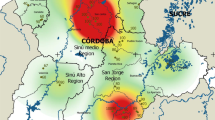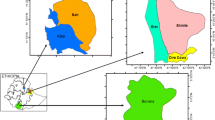Summary
This paper describes helminth infections in three groups of calves of different ages grazing naturally infested pastures from March 1987 to May 1988.
Calves in which the faecal egg output was followed from birth showedToxocara vitulorum eggs as early as two days after birth and maximum patency occurred after two months. The fall inToxocara egg output coincided with a rise in that of the strongylates;Haemonchus spp.,Trichostrongylus spp. andOesophagostumum spp.
The influence of rainfall in dictating strongylate nematode infection was clear with high egg output during high rainfall and low egg counts when the rainfall was lower.
There was an indication that calves carry the infection from the end of the minor rainy season in November to the beginning of the next rains in March and then contribute to pasture contamination. However, calves born in December may remain uninfected until the onset of the rains.
Résumé
Cet article décrit les infestations à helminthes de 3 groupes de veaux d'âges différents pâturant sur des prés naturellement infectés, entre mars 1987 et mai 1988.
Le groupe 3, dans lequel le niveau des oeufs dans les fèces a été suivi depuis la naissance, a présenté des oeufs deToxocara vitulorum dès le deuxième jour, la mise en évidence maximale intervenant après 2 mois.
La chute dans l'émission des oeufs deToxocara a coïncidé avec l'élévation de ceux des strongyles tels queHaemonchus spp,Trichostrongylus spp etOesophagostomum spp.
L'influence de la pluviométrie comme facteur déterminant de l'infection par les strongyles a été démontrée par la corrélation entre le niveau élevé des comptages d'oeufs pendant les fortes précipitations et leur bas niveau lors des faibles pluviosités, dans les groupes 2 et 3. On a noté que les veaux peuvent héberger l'infestation depuis la fin de la petite saison des pluies (en novembre) jusqu'au commencement des pluies suivantes en mars, ce qui peut contribuer à la contamination des pâturages. Cependant des veaux nés en décembre peuvent rester indemnes jusqu'au début des pluies.
Resumen
Este trabajo discute infecciones helmínticas en tres grupos de terneras de edades diferentes, las cuales patoreaban pasturas infectadas, de marzo 1987 a mayo 1988.
El grupo 3 en el cual el conteo de huevos por gramo de heces se siguió desde el nacimiento, presentó huevos deToxocara vitulorum desde los tres días, occuriendo la prepatencia máxima a los dos meses de edad. La caída de los huevos deToxocara coincidió con el aumento de los de estrongiloides;Haemonchus spp,Trichostrongylus spp andOesophagostomum spp.
Se demuestra la influencia de la precipitación pluvial en la presencia de estrongilus, con una mayor cantidad de huevos por gramo de heces durante los meses de alta precipitación y de menor cantidad de huevos coincidiendo con una precipitación menor en ambos grupos, 2 y 3.
Hubo indicación de que los becerros pueden transportar la infección desde el final de la estación lluviosa menor en noviembre hasta el comienzo de la siguiente estación lluviosa en marzo lo cual contribuye a la contaminación de las pasturas. Sin embargo, los becerros nacidos en diciembre, podrían conservarse sin contaminación severa hasta el principio de las lluvias.
Similar content being viewed by others
References
Asanji, M. F. (1988).Journal of Helminthology,62, 243–249.
Assoku, R. K. G. (1979).Bulletin of Animal Health and Production in Africa,27, 29–39.
Assoku, R. K. G. (1981).Bulletin of Animal Health and Production in Africa,29, 1–10.
Beal, W. P. (1929). Annual Report of the Veterinary Department Gold Coast, 1928 to 1929.
Blitz, N. M. &Gibbs, H. C. (1972).International Journal of Parasitology,2, 13–22.
Chiejina, S. N. &Fakae, B. B. (1984).Research in Veterinary Science,37, 148–153.
Durie, P. H. (1961).Australian Journal of Agricultural Research,12, 1200–1211.
Durie, P. H. (1962).Australian Journal of Agricultural Research,13, 767–772.
Edwards, E. E. &Wilson, A. B. (1958).Journal of Helminthology,32, 195–210.
Graber, H. (1981).Bulletin of Animal Health and Production in Africa,29, 25–47.
Gupta, S. C. (1986).Indian Veterinary Journal,63, 71.
Hart, J. A. (1964).British Veterinary Journal,120, 87–95.
Hutchinson, J. A. (1962).Agriculture and Land Use. (Ed. J. Brian Wills). Ghana Ministry of Agriculture, Oxford University Press. London, pp 425–436.
Herbert, I. V. &Probert, A. J. (1987).Veterinary Record,121, 536–540.
Herlich, H. (1960).Journal of Parasitology,46, 392–397.
Jackson, C. (1965).Ghana Journal of Science,5, 65–70.
Keith, R. K. (1953).Australian Journal of Zoology,1, 223–235.
Lee, R. P., Armour, J. &Ross, J. G. (1960).British Veterinary Journal,116, 1–13.
Michel, J. F. (1969).Parasitology,59, 575–595.
Odei, M. A. (1966).Annals of Tropical Medicine and Parasitology,60, 215–218.
Rose, J. H. (1962).Journal of Comparative Pathology,72, 11–18.
Rose, J. H. (1964).Journal of Comparative Pathology,74, 163–168.
Soulsby, E. J. L. (1982).Helminths, Arthropods and Protozoa of Domesticated Animals. Baillière-Tindall. London. pp 168–172.
Sprent, J. F. A. (1946).Parasitology,37, 202–210.
Stewart, J. L. (1930). Annual Report of Principal Veterinary Officer, Gold Coast.
Thomas, R. J. &Bell, S. L. (1988).Veterinary Parasitology,29, 19–28.
Vegors, H. H. (1954).American Journal of Veterinary Research,15, 429–433.
Vercruysse, J. (1983).Veterinary Parasitology,13, 239–249.
Author information
Authors and Affiliations
Rights and permissions
About this article
Cite this article
Agyei, A.D. Epidemiological observations on helminth infections of calves in southern Ghana. Trop Anim Health Prod 23, 134–140 (1991). https://doi.org/10.1007/BF02356991
Accepted:
Issue Date:
DOI: https://doi.org/10.1007/BF02356991




